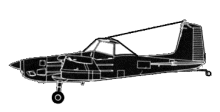
ASN Wikibase Occurrence # 209839
This information is added by users of ASN. Neither ASN nor the Flight Safety Foundation are responsible for the completeness or correctness of this information.
If you feel this information is incomplete or incorrect, you can submit corrected information.
| Date: | Saturday 21 September 1996 |
| Time: | 16:15 |
| Type: |  Cessna A188B/A1 |
| Owner/operator: | |
| Registration: | VH-JHZ |
| MSN: | 188-01678T |
| Fatalities: | Fatalities: 0 / Occupants: |
| Aircraft damage: | Substantial |
| Location: | 5km S of Tooraweenah, NSW -
 Australia Australia
|
| Phase: | Take off |
| Nature: | Agricultural |
| Departure airport: | Tooraweenah, NSW |
| Tooraweenah, NSW | |
| Investigating agency: | BASI |
| Confidence Rating: |
The aircraft was engaged in aerial seeding, and was being operated from a grass strip. The pilot reported the takeoff direction was towards the north-west, to take advantage of a 12-15 knot wind blowing from slightly left of the takeoff direction. The aircraft became airborne with about 100 metres of the strip remaining, but failed to accelerate and climb out of ground effect. Turbulence was encountered about 100 metres beyond the end of the strip, which yawed the aircraft to the right, through about 60 degrees. The pilot selected the hopper dump lever to the fully open position, in order to jettison the load, and attempted to manoeuvre the aircraft to avoid a line of trees. When it became apparent he would not be able to fly over the trees, he tracked towards the clearest area within the tree line. At a height of about ten feet the wings collided with small trees. The aircraft continued for a short distance before striking the ground and sliding to a halt. The pilot escaped without injury. He was subsequently told, by a person who had been located nearby, there had been a major wind gust/shift in the area at the time of the accident. After carrying out a damage inspection of the aircraft, the pilot reported that about 90% of the load had remained in the hopper during the accident sequence. Whilst he described the load of seed and superphosphate as dry and free flowing, he considered that the design of the hopper base was not satisfactory, as the gate-like opening inhibited the free flow of solids. Had he been able to jettison a greater portion of the hopper load in the time available, he believed the resulting improved climb performance of the aircraft would have allowed him to avoid the trees. The hopper base was described as a gate box type, principally designed for use with liquids. The pilot indicated that operators may use this style of hopper base for both liquid and solid applications during those times when the aircraft may be required to frequently change from one medium to the other.
Accident investigation:
 |
|
Sources:
https://www.atsb.gov.au/publications/investigation_reports/1996/aair/199603021/
https://www.atsb.gov.au/media/4932171/199603021.pdf
Revision history:
| Date/time | Contributor | Updates |
|---|---|---|
| 25-Apr-2018 07:30 | Pineapple | Added |
Corrections or additions? ... Edit this accident description
The Aviation Safety Network is an exclusive service provided by:


 ©2024 Flight Safety Foundation
©2024 Flight Safety Foundation